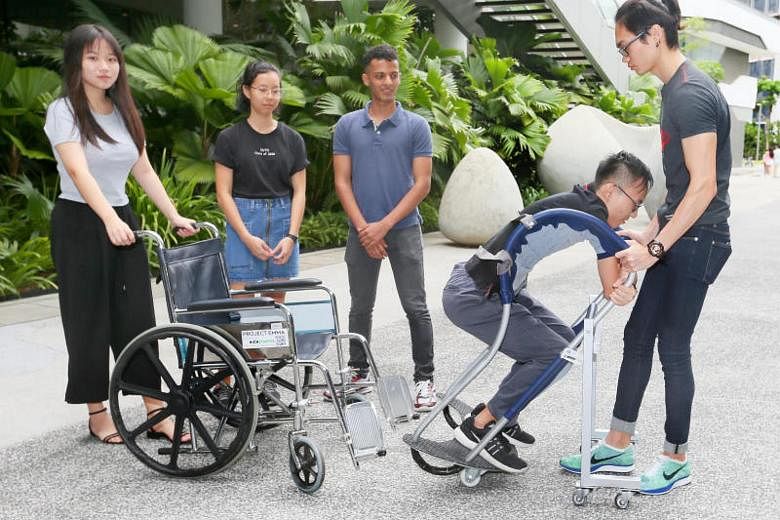SINGAPORE - Inspired by what they see as the needs of a rapidly greying population, five first-year students from the Singapore University of Technology and Design (SUTD) decided to make wheelchair users' lives easier.
They came up with the LambdaRoll: a device that helps caregivers move users from the wheelchair to another surface, such as the bed or toilet bowl.
The LambdaRoll resembles a wheelchair frame, and is about the same size. Wheelchair users are helped up from their chair before they are made to lean forward to get on the LambdaRoll seat.
With their arms secured on the device, the caregiver then guides the wheelchair user's feet onto a platform. Once the wheelchair user is completely on the device, the caregiver is able to move him around.
The LambdaRoll was one of 81 projects on public display on Friday (Dec 8) at the SUTD campus, as part of a design exhibition by first-year SUTD students doing the Introduction to Design core module. The exhibition also included live demonstrations of the devices.
This year's theme focused on technology that is wearable or related to the body.
"Lambda is a Greek letter that looks like our device, and Roll sounds like the rho value, a measure of resistivity in physics," said team member Bhavy Mital, 22.
Fellow team member Andrea Chong, 19, added: "As we researched, we felt it was right to move to a topic of such urgency."
By 2018, the share of the population that is 65 years and older will match those younger than 15 for the first time, according to a report by United Overseas Bank economist Francis Tan.
The LambdaRoll team involved nursing home residents in trying out their device and said they received positive feedback from the elderly. This has spurred them on to do more.
They recently applied for a technology disclosure to obtain a patent for their product, which they hope to one day commercialise.
The teams had to first come up with a problem statement based on a theme, and then research a solution before starting work on their prototypes in the sixth week. In all, most of them took three months to complete their projects.
"This is their first full and complete project," said Assistant Professor Christine Yogiaman, from the architecture and sustainable design department. "They learn very quickly how to visualise and demonstrate their works effectively."
Associate Professor of engineering product development Arlindo Silva added: "They have to put it out there to people they don't even know, who can say - and will say - all the good and bad things about it, so it's a culture shock for them in that sense.
"We tell them from day one about the exhibition, and that mentally prepares them and pushes them to showcase really high quality projects."
The two faculty members said the 450-strong batch has exceeded their expectations. In total, 46 faculty members from various disciplines - such as engineering, architecture, maths and physics - went around the booths to assess student teams of five to six. Each team had members from the same class.
The Introduction to Design course is a compulsory module for SUTD students at the middle term of their three-term first year in the university, testing them in both engineering and architecture.

